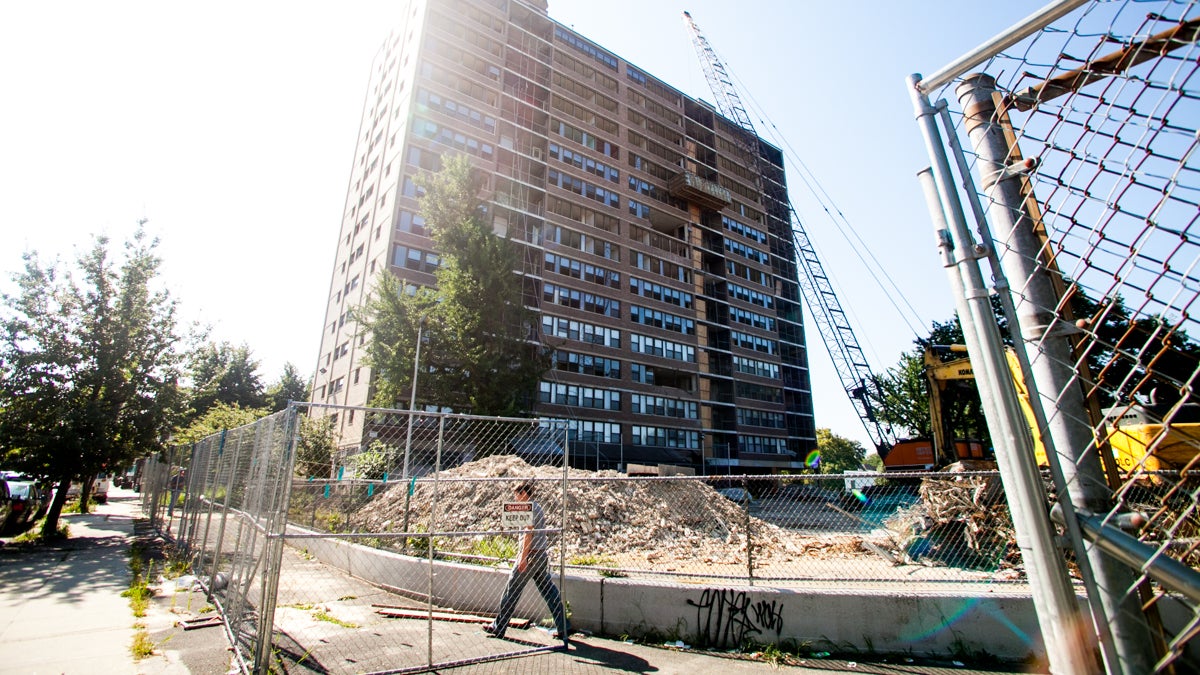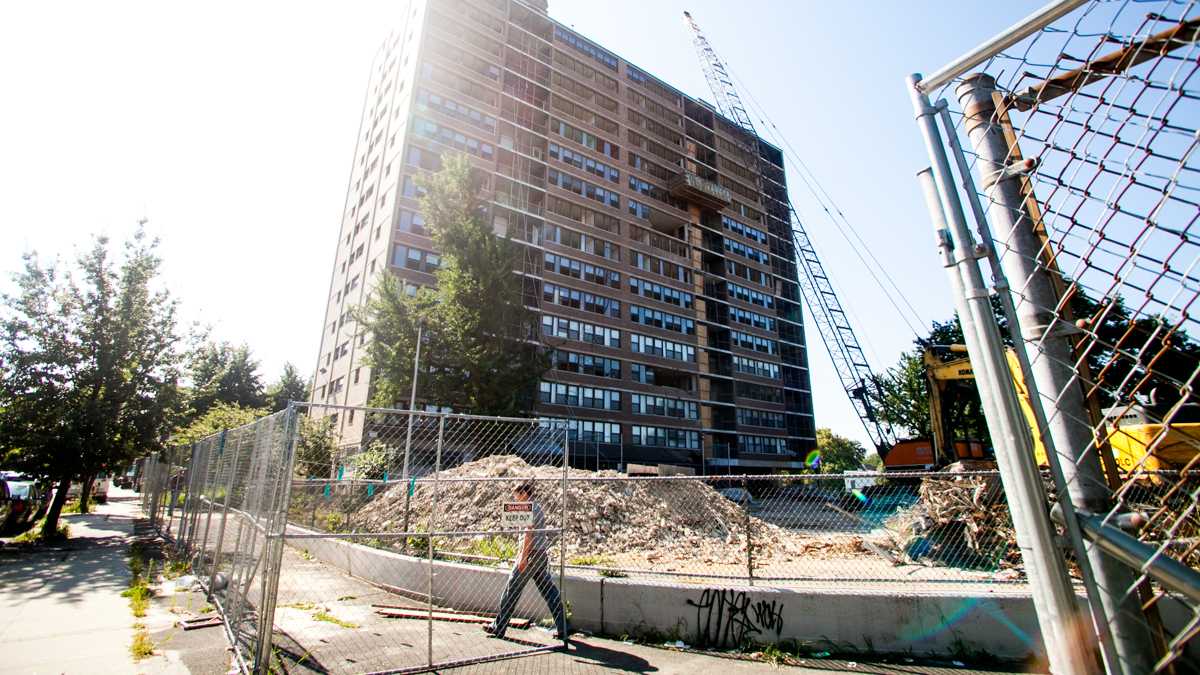Why the 14-second Queen Lane Apartments implosion will sound like ‘a thunderbolt’

Come Saturday, you won't be able to see the Queen Lane Apartments tower anymore. (Brad Larrison/for NewsWorks)
Fourteen seconds.
That’s roughly how long it will take to reduce Queen Lane Apartments to a pile of rubble Saturday morning, to end its nearly 60-year stay in west Germantown.
Only an implosion — among the safest and most precise methods for demolishing buildings — could raze a 16-story high-rise so quickly.
Or provide a more visually stunning demise.
How it works
With the help from a very small amount of explosives (not to mention gravity’s big contribution), the tower will collapse into itself and almost entirely within its own footprint, give or take about 15 feet.
“It’s going to look like a domino effect more or less, reaching the back side as the building starts to complete its failure,” said Jim Santoro, project coordinator for Controlled Demolition Inc. (CDI), the Maryland-based firm hired to fell the Philadelphia Housing Authority property.
Once the concrete structure is completely gutted, Santoro’s crew will drill a series of holes into carefully selected columns from top to bottom.
Sticks of dynamite — think “Looney Toons” cartoons — will then be concealed inside those openings to disrupt a given column’s ability to support itself and, in turn, the building.
The tower’s bones are otherwise left completely intact.
“If we remove [columns] in a sequence, and in a form marching back through the building, we can actually control the timing and the rate of failure and the direction of the fall,” said Santoro.
Gravity, though, does “99.9 percent” of the work.
It’s dynamite
Less than a pound of explosives will be placed at each of the roughly 426 locations, or charges, throughout the property.
Most of the dynamite will be loaded on the lower levels, especially the first floor. That’s where CDI wants to create the greatest amount of drop.
The upper floors are only wired with “extremely small charges” that aren’t even counted on to completely knock out the columns in which they’re placed.
“All they do is create a plane of fracture so that as the building starts to come down, it keeps breaking apart where we want it to break apart instead of randomly throughout the structure,” Santoro explained.
Top to bottom
During the implosion, charges on the lower levels are detonated first so that there’s a debris pile to cushion the tower’s top floors when they fall inward toward the ground.
All of it unfolds in, essentially, one continuous motion.
As charges are systematically detonated, the beam connections between columns tug on the column behind it.
“You don’t want it to break apart. You want to keep it as one, intact structure as it pulls itself down,” said Santoro. “That enables you to control where you’re taking it.”
On detonation
How the charges are detonated is a big part of that calculated sequence.
The explosives are detonated in batches using a series of extremely short, built-in delays that dictate how much time passes before a column is disrupted.
“We have either 10 or 11 delays in this building. So, you can more or less divide the 420-some charges by 10 or 11 delays and that’s how many are going off at any given moment,” said Santoro.
The time between detonations is only 360 to 500 milliseconds, a third of a second to half a second.
The implosion will start with what’s known as an initiation system — what happens right before any columns are detonated.
“It’ll sound like a series of booms sort of like a thunderbolt,” said Santoro.
Then, there’s a slight pause before the tower starts to come down in sections, sort of “like slicing a loaf of bread from the bottom up.”
More muffled booms mark this stage because the explosives are stuck inside the columns.
When the building hits the ground, it doesn’t do so as a monolith.
“Instead, it’s coming down as hundreds of thousands or millions of small pieces of debris, each striking the ground at a different moment,” said Santoro.
That means that the vibration caused by the implosion is nearly non-existent; it’s not even enough to knock a securely hung painting off the wall.
WHYY is your source for fact-based, in-depth journalism and information. As a nonprofit organization, we rely on financial support from readers like you. Please give today.
Why the 14-second Queen Lane Apartments implosion will sound like ‘a thunderbolt’

“It’s going to look like a domino effect more or less, reaching the back side as the building starts to complete its failure.”
–Jim Santoro, project coordinator, Controlled Demolition Inc.
The vibration caused by the implosion is nearly non-existent; it’s not even enough to knock a securely hung painting off the wall.
Fourteen seconds.
That’s roughly how long it will take to reduce Queen Lane Apartments to a pile of rubble Saturday morning, to end its nearly 60-year stay in west Germantown.
Only an implosion — among the safest and most precise methods for demolishing buildings — could raze a 16-story high-rise so quickly.
Or provide a more visually stunning demise.
How it works
With the help from a very small amount of explosives (not to mention gravity’s big contribution), the tower will collapse into itself and almost entirely within its own footprint, give or take about 15 feet.
“It’s going to look like a domino effect more or less, reaching the back side as the building starts to complete its failure,” said Jim Santoro, project coordinator for Controlled Demolition Inc. (CDI), the Maryland-based firm hired to fell the Philadelphia Housing Authority property.
Once the concrete structure is completely gutted, Santoro’s crew will drill a series of holes into carefully selected columns from top to bottom.
Sticks of dynamite — think “Looney Toons” cartoons — will then be concealed inside those openings to disrupt a given column’s ability to support itself and, in turn, the building.
The tower’s bones are otherwise left completely intact.
“If we remove [columns] in a sequence, and in a form marching back through the building, we can actually control the timing and the rate of failure and the direction of the fall,” said Santoro.
Gravity, though, does “99.9 percent” of the work.
It’s dynamite
Less than a pound of explosives will be placed at each of the roughly 426 locations, or charges, throughout the property.
Most of the dynamite will be loaded on the lower levels, especially the first floor. That’s where CDI wants to create the greatest amount of drop.
The upper floors are only wired with “extremely small charges” that aren’t even counted on to completely knock out the columns in which they’re placed.
“All they do is create a plane of fracture so that as the building starts to come down, it keeps breaking apart where we want it to break apart instead of randomly throughout the structure,” Santoro explained.
WHYY is your source for fact-based, in-depth journalism and information. As a nonprofit organization, we rely on financial support from readers like you. Please give today.







